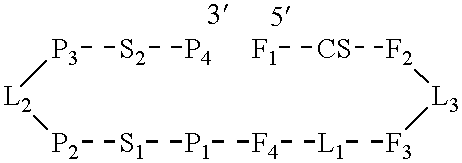Hairpin ribozymes
a ribozyme and ribozyme technology, applied in the field of rna catalysts, can solve the problems of low rna substrate cleavage, forestalling their use, and difficult, if not impossible, for the catalytic rna to cleave low levels of target rna substrates
- Summary
- Abstract
- Description
- Claims
- Application Information
AI Technical Summary
Problems solved by technology
Method used
Image
Examples
example 1
The (-) sense sequence of satellite RNA from the budblight strain of tobacco ringspot virus as shown in FIG. 2 was folded using the Wisconsin RNA folding program to identify the location of a possible catalytic complex accounting for its ability to self cleave (University of Wisconsin Genetics Computer Group, Program FOLD May 5, 1986) (Zucker, M. and Stiegler, P. (1981) Nucleic Acids Res., 9: 133-148; Devereux, J., Haeberli, P. and Smithies, O. (1984) Nucleic Acids Res., 12: 387-395). Base numbers correspond to (+)sTRSV RNA (Buzayan, J. M., Gerlach, W. L., Bruening, G. B., Keese, P. and Gould, A. R. (1986) Virology, 151: 186-199). With this numbering scheme the 5'-3' direction of the molecule is with decreasing base number.
The minimum catalytic complex, or active site of the molecule, is identified in FIG. 2. The folding identified regions of expected base pairing which are in classical double-helical or stem regions. The folding also identified expected non-base pairing loops at or...
example 2
A 50 nucleotide sequence between bases 175 and 224 was picked and a 14 nucleotide sequence between bases 40 and 53 was picked from the catalytic complex identified in Example 1. A catalytic RNA (R51) with the 50 base sequence shown in FIG. 1 plus one additional vector base (G at the 5' end) and a substrate RNA (S17) with the 14 base sequence shown in FIG. 1 plus three vector bases (GCG at the 5' end) were transcribed using T7 RNA polymerase from synthetic DNA templates double stranded at the promoter site (Milligan, J. F., Groebe, D. R., Witherell, G. W. and Uhlenbeck, O. C. (1987) Nuc. Acids Res., 15: 8783-8798). The synthetic DNA templates were made using phosphoramidite chemistry on an Applied Biosystems 381A DNA synthesizer. The template DNAs were: catalytic RNA R51: 3'-ATTATGCTGAGTGATATCTTTGTCTCTTCAGTTGGTCTCTTTGTGTGCAACACCATATAATGGACCAT-5' (SEQ ID NO 8) and substrate RNA S17: 3'-ATTATGCTGAGTGATATCGCACTGTCAGGACAAA-5' (SEQ ID NO 9).
Before transcription, a 18mer or 16mer DNA compl...
example 3
The catalytic RNA R51 was added to the substrate RNA S17 at a ratio of 1:30 and the time course of substrate RNA cleavage was studied. The reaction was carried out at 37.degree. C. in 12 mM MgCl.sub.2, 40 mM Tris pH 7.5 and 2 mM spermidine over a time period of 150 min and is summarized as follows: ##STR4##
The reaction products were separated on polyacrylamide / urea gels by electrophoresis and bands cut out and counted in a liquid scintillation counter. The results are shown in FIG. 3. The time periods analyzed were: lane 1, 30 sec; lane 2, 5 min; lane 3, 15 min; lane 4, 30 min; lane 5, 60 min; lane 6, 90 min and lane 7, 150 min. Beginning concentrations were as follows: R51=0.0032 uM and S17=0.09 uM.
As shown in FIG. 3, the cleavage proceeds to virtual completion during the course of the reaction with only 2% of the substrate remaining after 150 minutes. This shows that, since there was originally 30 times as much substrate RNA as catalytic RNA, the RNA catalyst R51 of necessity inte...
PUM
| Property | Measurement | Unit |
|---|---|---|
| temperature | aaaaa | aaaaa |
| temperature | aaaaa | aaaaa |
| pH | aaaaa | aaaaa |
Abstract
Description
Claims
Application Information
 Login to View More
Login to View More - R&D
- Intellectual Property
- Life Sciences
- Materials
- Tech Scout
- Unparalleled Data Quality
- Higher Quality Content
- 60% Fewer Hallucinations
Browse by: Latest US Patents, China's latest patents, Technical Efficacy Thesaurus, Application Domain, Technology Topic, Popular Technical Reports.
© 2025 PatSnap. All rights reserved.Legal|Privacy policy|Modern Slavery Act Transparency Statement|Sitemap|About US| Contact US: help@patsnap.com



